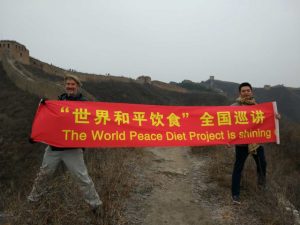Inspirations from China and Asia
By Dr. Will Tuttle
What can we learn about veganism and world peace from the ancient cultures of eastern Asia? During our recent four-week lecture tour to China, Taiwan, Vietnam, and Singapore, we received abundant inspiration and insight from these cultures. One of the most striking characteristics of these Asian cultures that we experienced, particularly with the vegan advocacy groups with whom we worked, was their healthy cooperativeness. It’s a bit hard to actually describe, but every day in a variety of ways I was struck, and at times awestruck, by the natural way the people had of working together harmoniously and productively.
For example, before Madeleine met up with me in Taiwan, I spent two weeks in China, giving about 20 lectures in twelve different cities in those fourteen days (Beijing > Guangzhou > Chengdu > Kunming > Xian > Taiyuan > Shenzhen > Hong Kong > Shanghai > Hangzhou > Haining > Xiamen). It was a grueling schedule for the three of us, (including Dr. Li Yu, the lecture tour organizer, and Jade Zheng, the interpreter), with flights nearly every day, and yet the cooperativeness, harmony, and enthusiasm of the event organizers and participants made it all heart-warming and joyful. Even when we arrived at 11:00 p.m. at an airport, there would be a delegation of local vegan advocates with big smiles, warm greetings, and a large bouquet of flowers to welcome us. The actual lecture events ran unusually smoothly, and day after day, night after night, the auditoriums and lecture halls were filled to capacity with enthusiastic attendees. It was common for me to sign a hundred or even several hundred books afterward, with long lines of people all working together graciously to make the many signings and photo-ops flow cheerfully and efficiently.
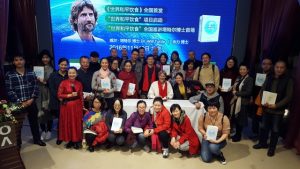 It is a feeling that’s hard to describe and that seems unfortunately a bit missing in the West. For me, there was a palpable sense of connectedness displayed that seemed rooted in centuries of working together to achieve common aims. There was also a sense of respect that I found touching and inspiring. It’s manifest in many of the cultural gestures and basic ways of doing things. Most of the meals we shared, for example, were at a table with a large round revolving server filled with a variety of dishes. The custom is for all of us to be continuously mindful of everyone else as we turn the rotating disc to access the foods we’d like, and to be sure that others are also able to get what they would like. Another example, whenever we present someone with something, for example, a book, a business card, or a gift, both people involved always extend both hands simultaneously, holding the object in both hands and receiving it with both hands as well, usually with a slight bow or nod. Again, there is a feeling in these traditions that cultivates a sense of respect for each other and for all the elements in the act of giving.
It is a feeling that’s hard to describe and that seems unfortunately a bit missing in the West. For me, there was a palpable sense of connectedness displayed that seemed rooted in centuries of working together to achieve common aims. There was also a sense of respect that I found touching and inspiring. It’s manifest in many of the cultural gestures and basic ways of doing things. Most of the meals we shared, for example, were at a table with a large round revolving server filled with a variety of dishes. The custom is for all of us to be continuously mindful of everyone else as we turn the rotating disc to access the foods we’d like, and to be sure that others are also able to get what they would like. Another example, whenever we present someone with something, for example, a book, a business card, or a gift, both people involved always extend both hands simultaneously, holding the object in both hands and receiving it with both hands as well, usually with a slight bow or nod. Again, there is a feeling in these traditions that cultivates a sense of respect for each other and for all the elements in the act of giving.
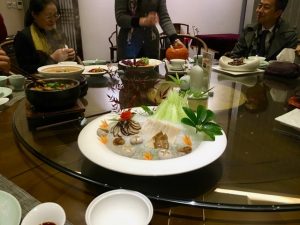 Regarding the actual practice of vegan living, it was refreshing to be in cultures where people easily understood the spiritual dimension of vegan living, and relished speaking and hearing about it. This again seems to be somewhat missing in the West, and is I believe a result of the wounding and hardened materialism inflicted on us here by centuries of animal exploitation and abuse. I realized that in China I was arguably in the actual birthplace of veganism as a philosophy and way of life. When we trace the roots of vegan and vegetarian living, we are drawn ineluctably back to Vedic India and the ancient yogic and Jain traditions that emphasize ahimsa, or nonviolence toward all living beings, as the foundation of inner peace and social harmony. Still today, India is the most vegetarian-friendly country in the world, but the tradition of eating dairy products and owning and enslaving cows for this is profoundly intertwined with Indian culture. Because of this ubiquity of dairy consumption, the vegan movement in India is still relatively young and small, though it is rapidly growing.
Regarding the actual practice of vegan living, it was refreshing to be in cultures where people easily understood the spiritual dimension of vegan living, and relished speaking and hearing about it. This again seems to be somewhat missing in the West, and is I believe a result of the wounding and hardened materialism inflicted on us here by centuries of animal exploitation and abuse. I realized that in China I was arguably in the actual birthplace of veganism as a philosophy and way of life. When we trace the roots of vegan and vegetarian living, we are drawn ineluctably back to Vedic India and the ancient yogic and Jain traditions that emphasize ahimsa, or nonviolence toward all living beings, as the foundation of inner peace and social harmony. Still today, India is the most vegetarian-friendly country in the world, but the tradition of eating dairy products and owning and enslaving cows for this is profoundly intertwined with Indian culture. Because of this ubiquity of dairy consumption, the vegan movement in India is still relatively young and small, though it is rapidly growing.
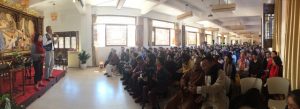 However, with the coming of Bodhidharma from India to China in the fifth century, bringing the Indian Buddhist teachings to a culture that never historically enslaved cows for milk or flesh, we find the genesis of a vibrant and authentically vegan culture in the Buddhist monasteries and temples that sprang up in China in the ensuing years. Over the centuries, these meditation centers became in many ways the cultural, spiritual, intellectual, and artistic hubs of Chinese culture, especially in the Tang, Song, and Ming dynasties. The China discovered by Marco Polo was far more advanced and refined than relatively primitive medieval Europe, and the demand for and interest in Chinese porcelains, arts, and culture helped spur Europe toward its Renaissance.
However, with the coming of Bodhidharma from India to China in the fifth century, bringing the Indian Buddhist teachings to a culture that never historically enslaved cows for milk or flesh, we find the genesis of a vibrant and authentically vegan culture in the Buddhist monasteries and temples that sprang up in China in the ensuing years. Over the centuries, these meditation centers became in many ways the cultural, spiritual, intellectual, and artistic hubs of Chinese culture, especially in the Tang, Song, and Ming dynasties. The China discovered by Marco Polo was far more advanced and refined than relatively primitive medieval Europe, and the demand for and interest in Chinese porcelains, arts, and culture helped spur Europe toward its Renaissance.
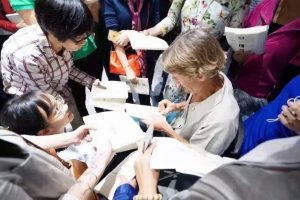 It was in these ancient Chinese Zen temples where we find one of the earliest and most robust flowerings of vegan culture that persists to this day in many of the Buddhist centers of China, Korea, Taiwan, Japan, and Vietnam. The monastic residents of these communities refrained from eating any animal-based foods or wearing leather or silk, and did it as part of their spiritual practice of ahimsa, which is the ethical foundation of today’s veganism. In fact, it was in these centers that the first plant-based meat analogs were created by the temple cooks, such as seitan. Although the monks and nuns lived on healthy regimes of rice, vegetables, fruits, beans, and tofu, affluent patrons would visit on special occasions, and to please them at their vegan feasts, the cooks invented the first faux pork, fish, duck, and chicken from plant-based ingredients. This living tradition of course continues to this day, and it has become one of the fastest growing sectors of the food industry, bringing plant-based meat, cheese, and other alternative products to millions of people.
It was in these ancient Chinese Zen temples where we find one of the earliest and most robust flowerings of vegan culture that persists to this day in many of the Buddhist centers of China, Korea, Taiwan, Japan, and Vietnam. The monastic residents of these communities refrained from eating any animal-based foods or wearing leather or silk, and did it as part of their spiritual practice of ahimsa, which is the ethical foundation of today’s veganism. In fact, it was in these centers that the first plant-based meat analogs were created by the temple cooks, such as seitan. Although the monks and nuns lived on healthy regimes of rice, vegetables, fruits, beans, and tofu, affluent patrons would visit on special occasions, and to please them at their vegan feasts, the cooks invented the first faux pork, fish, duck, and chicken from plant-based ingredients. This living tradition of course continues to this day, and it has become one of the fastest growing sectors of the food industry, bringing plant-based meat, cheese, and other alternative products to millions of people.
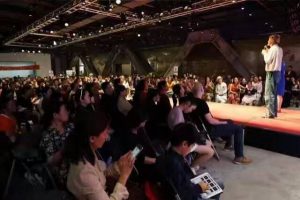 It seemed to me that the enthusiastic crowds that attended the lectures throughout China intuitively understood that vegan living has its roots in the ethical and spiritual practices of compassion, contemplation, and direct insight into the interconnectedness of all expressions of life. And refreshingly, they understood that there is no conflict between spiritual practice and the scientific research demonstrating that shifting to plant-based ways of eating and living would be dramatically healing not only for our Earth’s ecosystems but also for our society, as well as our bodies and minds. In fact, about six months prior to my Chinese lecture tour, the Chinese government, based on these findings, had mandated a fifty percent reduction in meat consumption in China. When I mentioned this to the Chinese audiences, and told them I hoped that the U.S. government would eventually be similarly wise, there was always hearty applause.
It seemed to me that the enthusiastic crowds that attended the lectures throughout China intuitively understood that vegan living has its roots in the ethical and spiritual practices of compassion, contemplation, and direct insight into the interconnectedness of all expressions of life. And refreshingly, they understood that there is no conflict between spiritual practice and the scientific research demonstrating that shifting to plant-based ways of eating and living would be dramatically healing not only for our Earth’s ecosystems but also for our society, as well as our bodies and minds. In fact, about six months prior to my Chinese lecture tour, the Chinese government, based on these findings, had mandated a fifty percent reduction in meat consumption in China. When I mentioned this to the Chinese audiences, and told them I hoped that the U.S. government would eventually be similarly wise, there was always hearty applause.
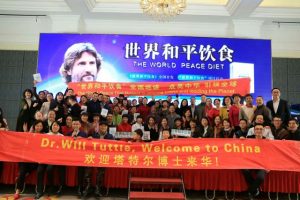 The entire lecture tour in China seemed to be blessed. No flights were delayed or luggage lost, and we were frequently able to find a few unoccupied rows at the back of the planes so we could squeeze in some sleep between events. And then there was Jade! Finding talented and simpatico vegan interpreters for the lectures in every city loomed as a huge challenge. After the first two lectures in Beijing, this was obvious, but when we landed in the second city, Guangzhou (Canton), we met Jade Zheng who was not only a remarkably gifted interpreter, but extraordinarily helpful in every way, so Dr. Yu wisely decided to invite her to travel with us for the entire tour, which she thankfully was free to do, and she assisted in countless ways.
The entire lecture tour in China seemed to be blessed. No flights were delayed or luggage lost, and we were frequently able to find a few unoccupied rows at the back of the planes so we could squeeze in some sleep between events. And then there was Jade! Finding talented and simpatico vegan interpreters for the lectures in every city loomed as a huge challenge. After the first two lectures in Beijing, this was obvious, but when we landed in the second city, Guangzhou (Canton), we met Jade Zheng who was not only a remarkably gifted interpreter, but extraordinarily helpful in every way, so Dr. Yu wisely decided to invite her to travel with us for the entire tour, which she thankfully was free to do, and she assisted in countless ways.
One t hing she didn’t have to interpret for was my piano music, and Dr. Yu had fortuitously required all lecture venues to have a piano on the stage, and I found that the unique power music has as a universal language was especially well received among the Chinese (and all the Asian) audiences. Veganism is in many ways an expression of a heart that has opened, and—while words, images, and examples are primary catalysts in opening hearts—rhythms, melodies, and harmonies have remarkable capacities in this regard as well.
hing she didn’t have to interpret for was my piano music, and Dr. Yu had fortuitously required all lecture venues to have a piano on the stage, and I found that the unique power music has as a universal language was especially well received among the Chinese (and all the Asian) audiences. Veganism is in many ways an expression of a heart that has opened, and—while words, images, and examples are primary catalysts in opening hearts—rhythms, melodies, and harmonies have remarkable capacities in this regard as well.
The World Peace Diet Project
The lecture tour kicked off what we are calling the World Peace Diet Project in China. With 1.3 billion people (compared to .3 billion in the U.S.), China obviously plays a critical role in the global vegan movement. I learned how quickly veganism is growing in China, supported by young people as is usual, but also by elders and traditionalists as well as by the government, science, and the media. In most cities, besides my lecture presentation on the World Peace Diet approach to vegan living, Dr. Yu would also give a lecture on the nutritional benefits of plant-based eating, and we would end with a panel on the stage where we’d be joined by local vegan activists, educators, filmmakers, restaurateurs, and entrepreneurs. It was illuminating to see the wide range of creative and grassroots approaches to spreading the vegan message all over China.
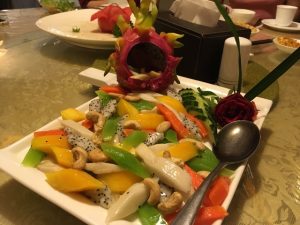 I also had remarkable opportunities to visit vegan restaurants and businesses. For example, in Guangzhou, one of the lectures was sponsored by a vegan products company, and when we toured their offices I was pleasantly surprised to discover that their business was booming and they had recently expanded to occupy an entire floor of a downtown skyscraper. Everyone in the business seemed to be under thirty and thriving in the company’s creative atmosphere. Later in the tour we visited a vegan baked goods factory in the Shanghai area that was similarly impressive. All the workers even came in on a Sunday to be there when we visited. Another remarkable discovery was a thriving vegan restaurant in Haining that had launched through local grassroots investment: over 130 local residents had invested in the restaurant by purchasing an equal share (the equivalent of around $3,000 I believe) and through this cooperative effort, they had created not just a thriving vegan restaurant, but a community gathering place treasured by many people.
I also had remarkable opportunities to visit vegan restaurants and businesses. For example, in Guangzhou, one of the lectures was sponsored by a vegan products company, and when we toured their offices I was pleasantly surprised to discover that their business was booming and they had recently expanded to occupy an entire floor of a downtown skyscraper. Everyone in the business seemed to be under thirty and thriving in the company’s creative atmosphere. Later in the tour we visited a vegan baked goods factory in the Shanghai area that was similarly impressive. All the workers even came in on a Sunday to be there when we visited. Another remarkable discovery was a thriving vegan restaurant in Haining that had launched through local grassroots investment: over 130 local residents had invested in the restaurant by purchasing an equal share (the equivalent of around $3,000 I believe) and through this cooperative effort, they had created not just a thriving vegan restaurant, but a community gathering place treasured by many people.
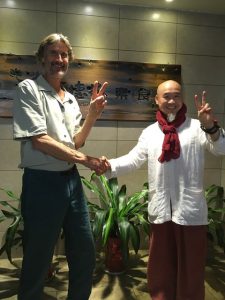 In Hong Kong the local vegan group created a successful vegfest around our lecture presentation with lots of booths and vendors, and this was done in some other cities as well. In Xiamen we met a particularly inspiring fellow: Master Ma Chuo. He has made a vow to bring the vegan message to every city in China, a daunting seven-year task that he is accomplishing, every day hitchhiking with a hundred-pound pack filled with vegan literature he distributes as he speaks in schools and cultural centers. Now in year five of his seven-year adventure, he radiates joy and vitality, an ageless and beautiful person dressed in the traditional white garments of a wandering Taoist who brings kindness and awareness wherever he goes, planting seeds of peace throughout China, with a vow to do the same in India when China is completed.
In Hong Kong the local vegan group created a successful vegfest around our lecture presentation with lots of booths and vendors, and this was done in some other cities as well. In Xiamen we met a particularly inspiring fellow: Master Ma Chuo. He has made a vow to bring the vegan message to every city in China, a daunting seven-year task that he is accomplishing, every day hitchhiking with a hundred-pound pack filled with vegan literature he distributes as he speaks in schools and cultural centers. Now in year five of his seven-year adventure, he radiates joy and vitality, an ageless and beautiful person dressed in the traditional white garments of a wandering Taoist who brings kindness and awareness wherever he goes, planting seeds of peace throughout China, with a vow to do the same in India when China is completed.
How can we rest when animals are suffering so severely and in need of our aid?
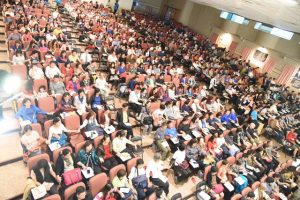 In China we were also able to reach millions of people through interviews and recordings distributed by the media and online. The momentum of the vegan movement in China seems to be rapidly increasing, and it was heartening to see how the World Peace Diet holistic approach to veganism resonates naturally with vegans in China. Some explained to me that in the Chinese language, the word “vegan” is difficult to express precisely, and some are saying “world peace diet” instead of “vegan diet” and “world peace living” instead of “veganism.” The yearning for world peace is universal and profound, and it’s connecting increasingly with veganism in China, and as we saw next during the following week, in Taiwan as well.
In China we were also able to reach millions of people through interviews and recordings distributed by the media and online. The momentum of the vegan movement in China seems to be rapidly increasing, and it was heartening to see how the World Peace Diet holistic approach to veganism resonates naturally with vegans in China. Some explained to me that in the Chinese language, the word “vegan” is difficult to express precisely, and some are saying “world peace diet” instead of “vegan diet” and “world peace living” instead of “veganism.” The yearning for world peace is universal and profound, and it’s connecting increasingly with veganism in China, and as we saw next during the following week, in Taiwan as well.
Taiwan: The Vegan Pioneer
Taiwan is, it seems, the most vegan country in the world. Not only are there more than a thousand vegetarian and vegan restaurants on this little island, there is a booming vegan movement as well as a strong organic movement. This was encouraging to experience after being in China, where it is still difficult for many to access organic foods. The widespread vegan and organic awareness in Taiwan is due primarily to the Buddhist temples and organizations that form the heart of Taiwanese culture, and have millions of adherents. The Mahayana Buddhist tradition is vegan in its foundations, and so the general feeling in the populace is that eating meat is somewhat questionable. Dairy tends to be more popular, because it is a relatively recent arrival and is also not obviously causing harm to animals in peoples’ minds.
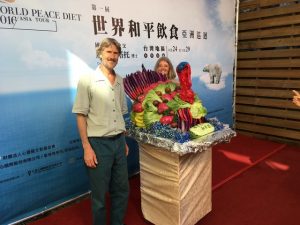 Fortunately there are many Buddhist and other groups such as the Meat-free Monday group working to educate the populace about the health, environmental, and ethical problems with dairy production. Because there is little land for large-scale animal agriculture, there is virtually no industry opposition to these educational efforts, and the government, as in China, is less corrupted than in the U.S. and Western countries through the typical massive infiltration and lobbying by animal agriculture, fast food, chemical, pharmaceutical, defense, and banking interests, all of whom profit from these foods, and the disease and war they cause.
Fortunately there are many Buddhist and other groups such as the Meat-free Monday group working to educate the populace about the health, environmental, and ethical problems with dairy production. Because there is little land for large-scale animal agriculture, there is virtually no industry opposition to these educational efforts, and the government, as in China, is less corrupted than in the U.S. and Western countries through the typical massive infiltration and lobbying by animal agriculture, fast food, chemical, pharmaceutical, defense, and banking interests, all of whom profit from these foods, and the disease and war they cause.
The Clean Life Foundation, a nondenominational spiritual group that promotes meditation, yoga, and clean living, organized our lecture tour in Taiwan. They were effective, creative and enthusiastic in their efforts and our tour in Taiwan was delightful. The first event was a press conference that attracted all the major media, featuring an enormous turkey made completely out of fruits and vegetables in honor of Thanksgiving. Additionally there were creative dances inspired by animals and short speeches about the environmental and cultural benefits of vegan living. Later in the week, we participated in a second similarly successful press event in a hotel in a different city, and this one featured a vegan-inspired fashion show created by one of the most respected fashion designers in Taiwan.
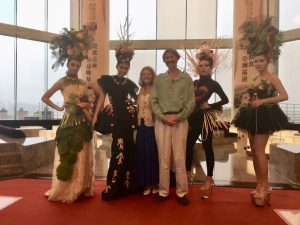 Besides speaking at these press events that brought the vegan message to a nationwide audience, we delivered lecture presentations in remarkably well-organized venues in several cities. The lecture in Taichung drew over 700 people, and we also had the opportunity to present workshops and concerts (piano and flute) and for Madeleine to give a vegan cooking class at a local restaurant. We met a team opening the world’s first completely vegan large-scale hotel, and participated in an evening showcasing the creative vegan advocacy efforts of Taiwanese children and teens. Visiting several vegan restaurants and bakeries and discussing strategies and possibilities with local advocates, we got an uplifting glimpse into the broad and deep progress being made in promoting vegan living in Taiwan, propelled by the youth, and also by the religious and spiritual organizations that promote meditation, kindness to others, and respect for all life.
Besides speaking at these press events that brought the vegan message to a nationwide audience, we delivered lecture presentations in remarkably well-organized venues in several cities. The lecture in Taichung drew over 700 people, and we also had the opportunity to present workshops and concerts (piano and flute) and for Madeleine to give a vegan cooking class at a local restaurant. We met a team opening the world’s first completely vegan large-scale hotel, and participated in an evening showcasing the creative vegan advocacy efforts of Taiwanese children and teens. Visiting several vegan restaurants and bakeries and discussing strategies and possibilities with local advocates, we got an uplifting glimpse into the broad and deep progress being made in promoting vegan living in Taiwan, propelled by the youth, and also by the religious and spiritual organizations that promote meditation, kindness to others, and respect for all life.
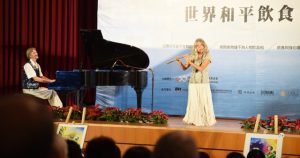 The Clean Life Foundation, like quite a few other spiritual groups, offers courses that help people live more mindfully and plant seeds of peace, joy, and health in their lives. We also visited the Tzu Chi Foundation, a movement of over ten million people, founded by the Buddhist nun and meditation master Cheng Yen, which assists people worldwide with food and disaster aid. We were especially honored to be able to meet the elderly and iconic Cheng Yen personally and thank her for her terrific work, and to present her with the Chinese version of The World Peace Diet.
The Clean Life Foundation, like quite a few other spiritual groups, offers courses that help people live more mindfully and plant seeds of peace, joy, and health in their lives. We also visited the Tzu Chi Foundation, a movement of over ten million people, founded by the Buddhist nun and meditation master Cheng Yen, which assists people worldwide with food and disaster aid. We were especially honored to be able to meet the elderly and iconic Cheng Yen personally and thank her for her terrific work, and to present her with the Chinese version of The World Peace Diet.
Vietnam, Singapore, and Hawaii
The next stops were Hanoi and Ho Chi Minh City, and in Vietnam we were impressed both by the dedication of the vegan activists, and also by the difficulties they face in not being allowed by the government to put on public events or gatherings without special permission. Additionally, we were told that there is a massive advertising campaign underway in Vietnam to promote dairy products to the people, with ads and articles appearing constantly in the media about the benefits of milk and cheese. As everywhere in Asia, we were treated with tremendous kindness, and the lecture events were well attended and pianos were provided.
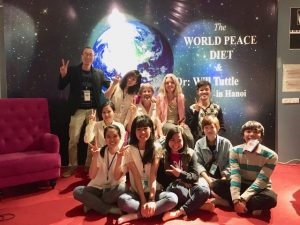 Besides the main lecture event in Singapore, which was beautifully organized and well-attended, we had the opportunity to speak and concertize in the Canadian-sponsored international school there, and share the vegan message with the youth, who seemed genuinely interested and open. With Singapore, the most westernized of all the countries we visited, we were transitioning to the final leg of our lecture tour: three weeks in the Hawaiian islands of Hawaii, Maui, and Kauai. Again, we were encouraged to see the progress being made in Hawaii through the dedicated efforts of local activists on all three islands. We delivered two World Peace Diet Facilitator Training Retreats as well as a well-organized series of lectures, gatherings, and concerts, and by the end of our time in Hawaii, our hearts were filled with inspiration and gratitude.
Besides the main lecture event in Singapore, which was beautifully organized and well-attended, we had the opportunity to speak and concertize in the Canadian-sponsored international school there, and share the vegan message with the youth, who seemed genuinely interested and open. With Singapore, the most westernized of all the countries we visited, we were transitioning to the final leg of our lecture tour: three weeks in the Hawaiian islands of Hawaii, Maui, and Kauai. Again, we were encouraged to see the progress being made in Hawaii through the dedicated efforts of local activists on all three islands. We delivered two World Peace Diet Facilitator Training Retreats as well as a well-organized series of lectures, gatherings, and concerts, and by the end of our time in Hawaii, our hearts were filled with inspiration and gratitude.
Being able to co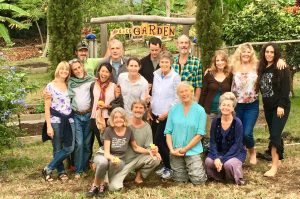 ntribute to this movement, and to work together with other grassroots activists in communities throughout Asia and the Pacific, is an honor and fortuitous opportunity. Animals, ecosystems, workers, hungry children, and future generations are in dire need of a complete transformation in the way we live, eat, and relate. We have seen, embraced, laughed, wept, and worked with the kindred spirits in countries, cities, and villages throughout this planet who share the world peace vision of respect for all life. This vegan movement is bigger than all of us, and yet it needs all of us.
ntribute to this movement, and to work together with other grassroots activists in communities throughout Asia and the Pacific, is an honor and fortuitous opportunity. Animals, ecosystems, workers, hungry children, and future generations are in dire need of a complete transformation in the way we live, eat, and relate. We have seen, embraced, laughed, wept, and worked with the kindred spirits in countries, cities, and villages throughout this planet who share the world peace vision of respect for all life. This vegan movement is bigger than all of us, and yet it needs all of us.
Thanks to you, and to all who hear the call, for contributing your unique wisdom and effort to help unfold this global transformation that now, more than ever, is essential.
